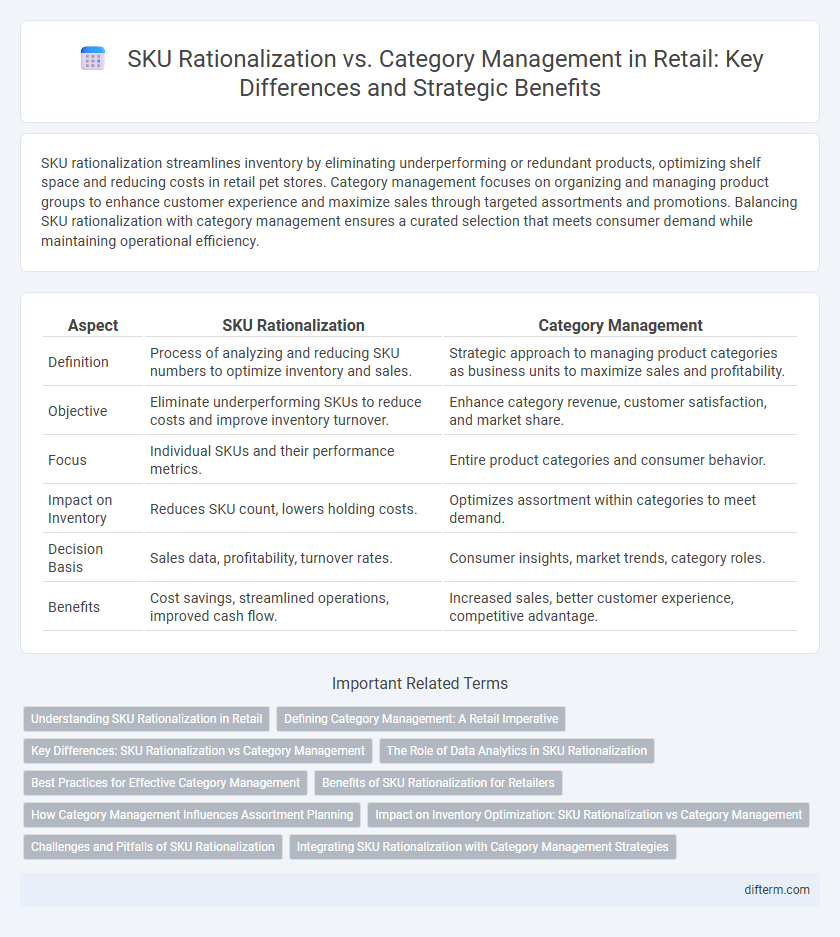SKU rationalization streamlines inventory by eliminating underperforming or redundant products, optimizing shelf space and reducing costs in retail pet stores. Category management focuses on organizing and managing product groups to enhance customer experience and maximize sales through targeted assortments and promotions. Balancing SKU rationalization with category management ensures a curated selection that meets consumer demand while maintaining operational efficiency.
Table of Comparison
| Aspect | SKU Rationalization | Category Management |
|---|---|---|
| Definition | Process of analyzing and reducing SKU numbers to optimize inventory and sales. | Strategic approach to managing product categories as business units to maximize sales and profitability. |
| Objective | Eliminate underperforming SKUs to reduce costs and improve inventory turnover. | Enhance category revenue, customer satisfaction, and market share. |
| Focus | Individual SKUs and their performance metrics. | Entire product categories and consumer behavior. |
| Impact on Inventory | Reduces SKU count, lowers holding costs. | Optimizes assortment within categories to meet demand. |
| Decision Basis | Sales data, profitability, turnover rates. | Consumer insights, market trends, category roles. |
| Benefits | Cost savings, streamlined operations, improved cash flow. | Increased sales, better customer experience, competitive advantage. |
Understanding SKU Rationalization in Retail
SKU rationalization in retail involves the strategic evaluation and reduction of stock keeping units to streamline inventory, optimize shelf space, and improve profitability. This process focuses on analyzing sales data, product performance, and customer demand to eliminate underperforming SKUs while maintaining essential variety for shopper satisfaction. Effective SKU rationalization enhances supply chain efficiency, reduces carrying costs, and supports category management by enabling more targeted merchandising and inventory decisions.
Defining Category Management: A Retail Imperative
Category management in retail involves organizing products into specific groups to optimize sales, enhance customer experience, and improve inventory efficiency. It relies on data-driven insights to create tailored strategies for each category, driving targeted promotions, assortment planning, and supplier negotiations. Effective category management aligns merchandising efforts with consumer demand, ensuring a balanced product mix and increased profitability.
Key Differences: SKU Rationalization vs Category Management
SKU Rationalization focuses on analyzing and optimizing the number of stock-keeping units to eliminate underperforming products and improve inventory efficiency, whereas Category Management emphasizes strategic planning and management of product categories to maximize overall category sales and profitability. SKU Rationalization primarily deals with product-level decisions, inventory costs, and SKU performance metrics, while Category Management involves supplier collaboration, merchandising strategies, and consumer behavior insights. The key difference lies in SKU Rationalization's tactical reduction of SKUs contrasted with Category Management's holistic approach to category growth and market positioning.
The Role of Data Analytics in SKU Rationalization
Data analytics plays a crucial role in SKU rationalization by enabling retailers to identify underperforming products and eliminate redundant SKUs, improving shelf space efficiency and inventory turnover. Advanced analytics tools analyze sales trends, customer preferences, and profitability metrics to optimize SKU assortment, reducing carrying costs and enhancing overall category profitability. Leveraging data-driven insights helps retailers make informed decisions, ensuring that SKU rationalization complements category management strategies for better alignment with market demand.
Best Practices for Effective Category Management
Effective category management relies on continuous SKU rationalization to optimize product assortment based on sales data and consumer preferences, enhancing shelf productivity and inventory turnover. Leveraging advanced analytics tools to identify underperforming SKUs allows retailers to streamline inventory while focusing on high-margin, high-demand products that align with category objectives. Collaboration with suppliers and cross-functional teams ensures accurate demand forecasting and dynamic assortment adjustments, promoting overall category growth and profitability.
Benefits of SKU Rationalization for Retailers
SKU rationalization streamlines inventory by eliminating underperforming products, reducing carrying costs and freeing up shelf space for high-demand items. This targeted approach improves supply chain efficiency and enhances data accuracy for better decision-making. Retailers benefit from increased profitability, optimized stock levels, and improved customer satisfaction through a more focused product assortment.
How Category Management Influences Assortment Planning
Category management strategically guides assortment planning by analyzing consumer behavior, sales data, and market trends to optimize product selection within each category. This approach ensures the right SKU mix that meets customer needs while maximizing shelf space and profitability. Unlike SKU rationalization, which focuses on eliminating underperforming SKUs, category management fosters collaborative supplier relationships and category-specific strategies to enhance overall business performance.
Impact on Inventory Optimization: SKU Rationalization vs Category Management
SKU Rationalization streamlines inventory by eliminating underperforming products, reducing excess stock and lowering carrying costs, which directly enhances inventory turnover rates. Category Management optimizes product assortment based on consumer demand patterns and market trends, improving shelf space allocation and maximizing sales potential within each category. Both strategies significantly impact inventory optimization, with SKU Rationalization focusing on cost reduction and Category Management driving sales efficiency through targeted assortment planning.
Challenges and Pitfalls of SKU Rationalization
SKU rationalization often faces challenges such as inaccurate sales data analysis, leading to the removal of profitable items and loss of customer loyalty. Overlooking category management principles can result in a skewed product assortment that fails to meet diverse consumer needs. Ineffective communication between cross-functional teams frequently leads to misaligned objectives and implementation delays in SKU rationalization projects.
Integrating SKU Rationalization with Category Management Strategies
Integrating SKU rationalization with category management strategies enhances inventory efficiency by aligning product assortment with consumer demand and category performance metrics. SKU rationalization involves systematically evaluating and trimming underperforming SKUs to optimize shelf space, while category management focuses on tailoring product mix to meet shopper needs and maximize category profitability. Combining these approaches enables retailers to streamline offerings, improve supply chain responsiveness, and drive category growth through data-driven decisions and customer-centric assortment planning.
SKU Rationalization vs Category Management Infographic

 difterm.com
difterm.com